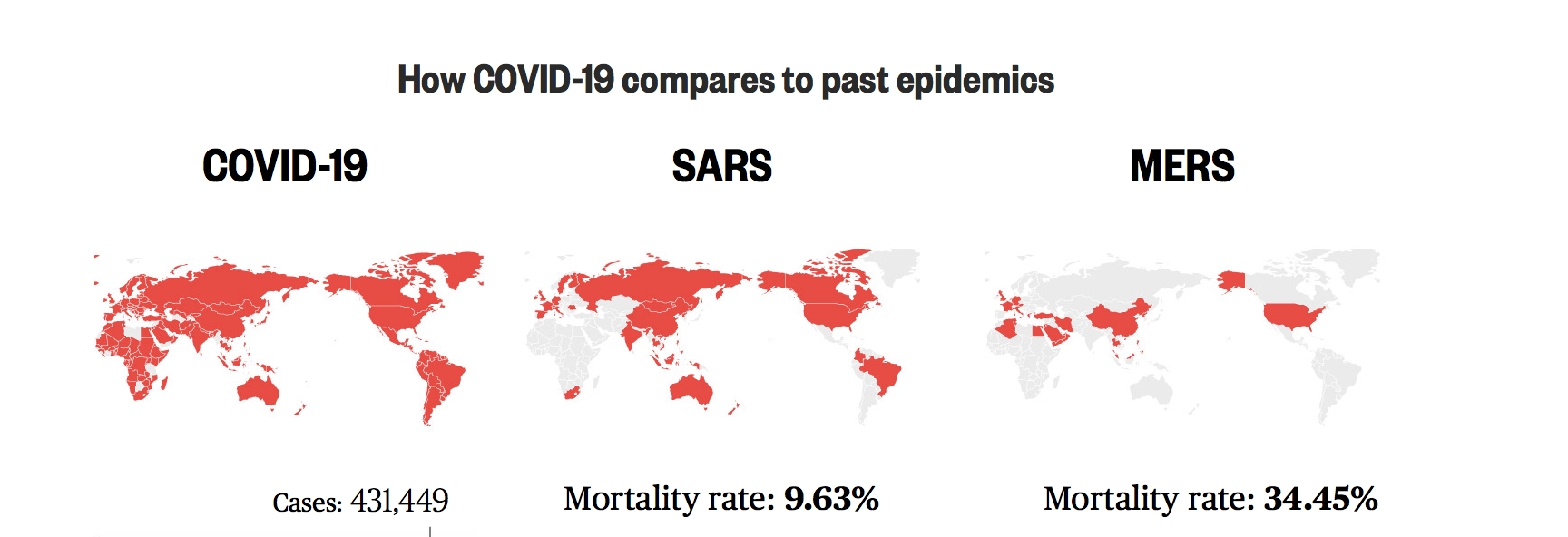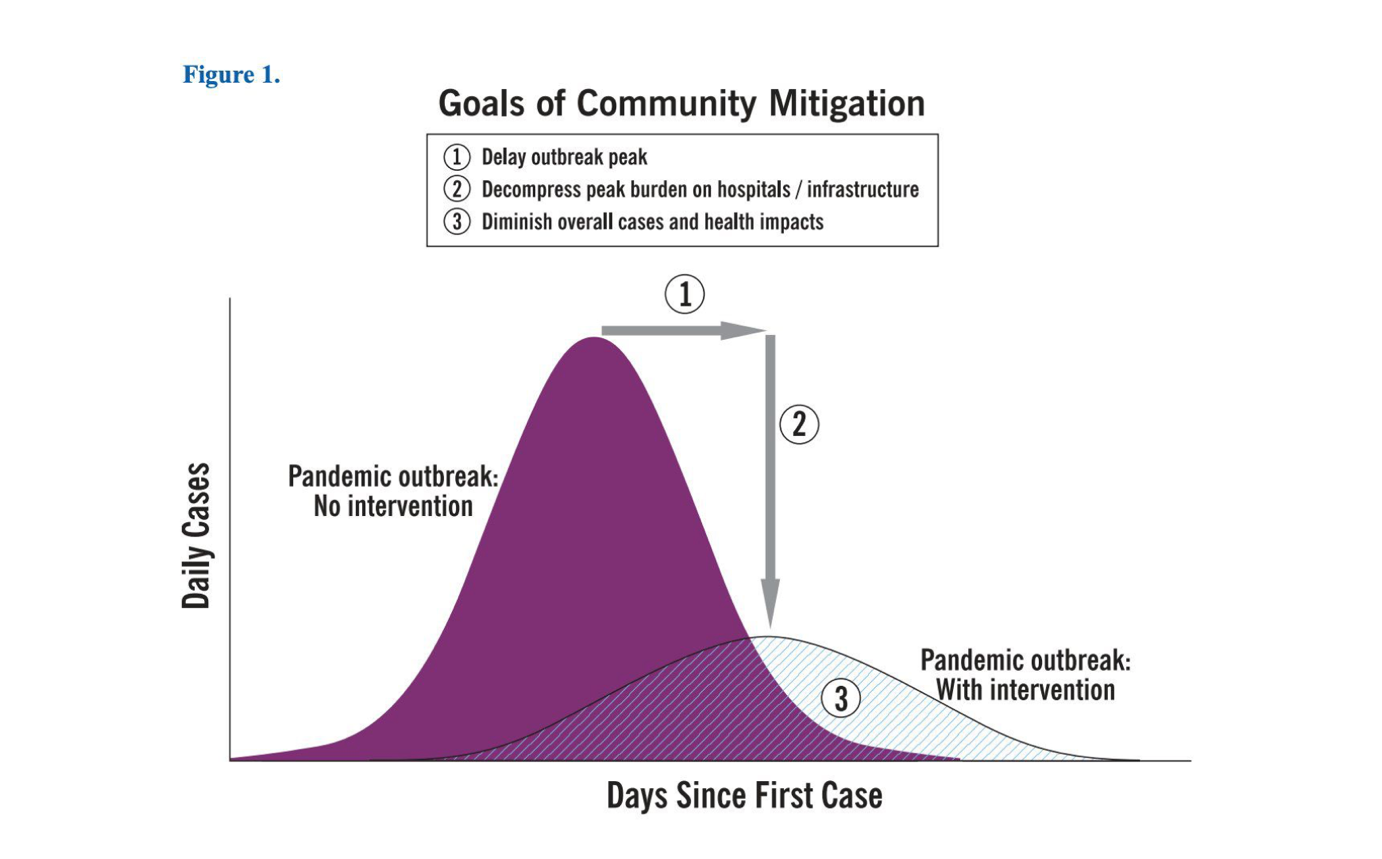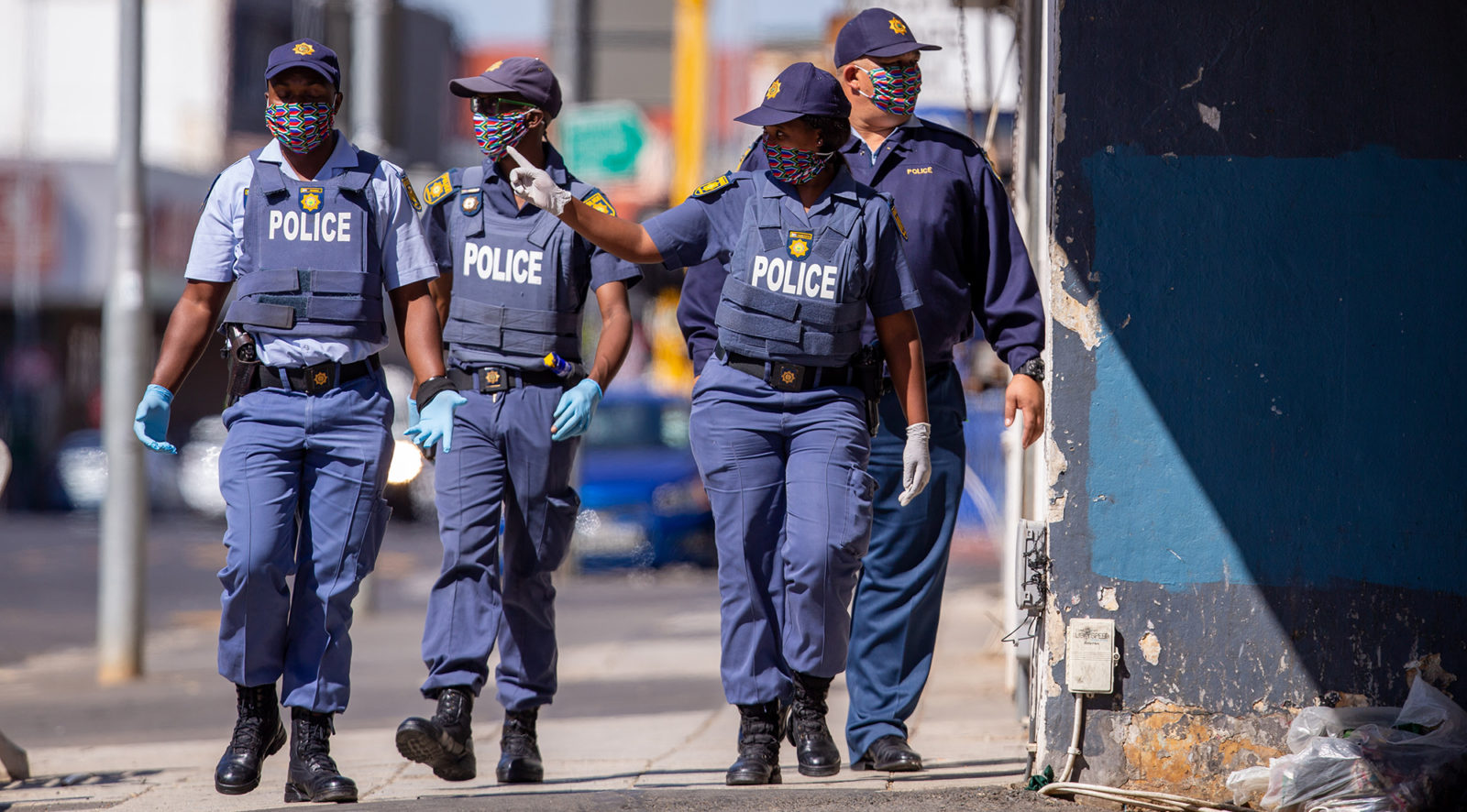COVID-19 versus the Corona virus:
What is COVID-19 Exactly?
COVID-19 is an infectious respiratory disease that developed from a type of Corona virus. [1] A Corona virus is a virus commonly found in all kinds of animals, which are sometimes able to evolve into forms that can infect humans (in this case, COVID-19). [2] In other words, there are different Corona viruses, but the one that is affecting the world in 2020 is more specifically known as COVID-19. The name was given to this deadly disease by The World Health Organization (WHO) after its discovery in December 2019. [3] The name can be broken up into the following: “C-O” and “V-I” refers to the “Corona virus”, where the “D” represents “disease” and finally “19” represents the year of discovery. [4]
Where did COVID-19 Originate from?
COVID-19 was discovered in Wuhan, China, by local public health officials. [5] It was originally thought that COVID-19 originated from a seafood market in Wuhan, but it is still unclear whether this fact is completely true. [6] Early genetic analyses suggested that COVID-19 originated from a group of bats and was later transmitted to a secondary unknown animal, and then finally to a human. [7] However, it is worth mentioning that scientists later discovered that the genomic (the complete set of an organism’s DNA and genes) structure of the virus is more likely to have been discovered in a group of pangolins. [8] Although this is the case, it is important to note that more recent studies are still being conducted and that they indicate that COVID-19 is a “recombination” (hybrid) between two different viruses. [9] Although it seems that COVID-19 is yet to be the deadliest of the Corona viruses, it is not the first of its kind. In fact, there have been two other corona-outbreaks since the beginning of the century.
Previous Corona-outbreaks since 2000
Severe Acute Respiratory Syndrome (SARS):
The first Corona virus outbreak in this century occurred in 2002 and was called “Severe Acute Respiratory Syndrome” (SARS). [10] The first case of SARS was reported in Guangdong, a province in Southern China, in November 2002. [11] By February 2003 it had spread to two-dozen other countries in North America, South America, Europe and Asia. [12] It was found that the virus was most likely spread from a group of bats to a group of civet cats and eventually to a human in Guangdong. [13] Fortunately, SARS was contained within six months and according to the WHO only affected approximately 8 098 people (with 774 reported deaths). [14]
Middle East Respiratory Syndrome (MERS):
The second outbreak of a Corona virus occurred in Saudi Arabia in September 2012 and was called the “Middle East Respiratory Syndrome” (MERS). [15] MERS was said to most likely have originated from a group of bats and this was transferred to a group of camels and eventually to a human in Saudi Arabia. [16] Although MERS only affected approximately 2 499 people, 861 deaths were reported, [17] meaning that MERS had a mortality rate of 34,5%. The largest outbreak of MERS occurred in the Republic of South Korea in 2015 and all cases were linked to people who had travelled to or from the Arabian Peninsula. [18] The symptoms of MERS included fever, coughing and shortness of breath (similar to the symptoms of both COVID-19 and SARS). [19]
 An illustration demonstrating how the COVID-19 cases (as recorded on 5 March 2020) compare to cases of SARS (2002) and MERS (2012). Image Source(Accessed on 1 April 2020)
An illustration demonstrating how the COVID-19 cases (as recorded on 5 March 2020) compare to cases of SARS (2002) and MERS (2012). Image Source(Accessed on 1 April 2020)
Currently there are approximately 882 751 reported cases and 44 150 reported deaths in the world (as recorded on 1 April 2020). [20] The WHO reported in March that although the virus originated in China, the epicentre for COVID-19 has now moved to Europe. [21] However, it should be mentioned that the United States of America (USA) currently has the highest number of cases (188 881 reported cases) than anywhere else in the world (as reported on 1 April 2020). [22] As it stands now, many countries have implemented “lockdowns” (where citizens are required to self-isolate in their homes). The reason for some countries implementing lockdowns is to attempt to “flatten the curve”. [23] In other words, to slow the rate of new cases and infections in order to prevent the rapid spread of the disease, as well as to prevent the overwhelming of public and private health systems. [24] This system has also been adopted by South Africa.
 A figure representing an approximation of how community mitigation will work to flatten the curve of the spread of COVID-19. Image source (Accessed on 1 April 2020).
A figure representing an approximation of how community mitigation will work to flatten the curve of the spread of COVID-19. Image source (Accessed on 1 April 2020).
South Africa versus COVID-19:
Since the first reported case of COVID-19 in South Africa on 4 March 2020, the country’s circumstances (like many other countries) have changed significantly. The first “big” change was initiated by South African President, Cyril Ramaphosa, on 15 March 2020 when the President addressed the South African nation and declared a national state of disaster. [25] President Cyril Ramaphosa declared that “this situation calls for an extraordinary response; there can be no half measures”. [26] President Cyril Ramaphosa said that contact between South African citizens and those possibly exposed to the virus should be limited. Consequently, and as he announced, any events or situations that expected the attendance of more than 100 people was to be immediately cancelled or postponed, schools were expected to close on Wednesday 18 March and any physical contact with high-risk countries (such as the United Kingdom, the United States of America, China, Iran or South Korea) was strongly advised against. [27] The address on 15 March was just the beginning of South Africa’s change amidst the COVID-19 outbreak.
The President’s full address to the nation, on 15 March, can be watched on the following YouTube link:
On Monday, 23 March 2020, President Cyril Ramaphosa once again addressed the nation. However, since his address on 15 March, it was clear that much had changed in the eight days as President Cyril Ramaphosa announced that there was going to be a 21-day “draconian lockdown” (draconian referring to extremely strict government actions) of South Africa at midnight on 26 March 2020. [29] The lockdown requires all South Africans and/or people in South Africa to remain in their homes for 21 days. People are only permitted to leave their homes for essential reasons (as listed below).
President Cyril Ramaphosa’s address on 23 March can be watched on the following YouTube link: [30]
By 1 April 2020, South Africa had 1 353 confirmed cases and 5 Corona virus-related deaths. [31]
Acceptable reasons to leave your home during the lockdown: [32]
- seek medical care
- buy groceries
- visit the pharmacy
- access banking services
- get petrol/diesel
- collect social grants
 South African Police officers patrolling a street in Woodstock, Cape Town. Image source (Accessed on 1 April 2020).
South African Police officers patrolling a street in Woodstock, Cape Town. Image source (Accessed on 1 April 2020).
End notes
[1] Unknown Author, “Coronavirus,” World Health Organization, (Updated: 2020), (Accessed: 1 April 2020), Available at https://www.who.int/health-topics/coronavirus#tab=tab_1 ↵
[2] N. Wetsman, “Everything You Need to Know About the Coronavirus,” The Verge, (Updated: 1 April 2020), (Accessed: 1 April 2020), Available at https://www.theverge.com/2020/1/23/21078457/coronavirus-outbreak-china-wuhan-quarantine-who-sars-cdc-symptoms-risk ↵
[3] N. Wetsman, “Everything You Need to Know About the Coronavirus,” The Verge, (Updated: 1 April 2020), (Accessed: 1 April 2020), Available at https://www.theverge.com/2020/1/23/21078457/coronavirus-outbreak-china-wuhan-quarantine-who-sars-cdc-symptoms-risk ↵
[4] N. Wetsman, “Everything You Need to Know About the Coronavirus,” The Verge, (Updated: 1 April 2020), (Accessed: 1 April 2020), Available at https://www.theverge.com/2020/1/23/21078457/coronavirus-outbreak-china-wuhan-quarantine-who-sars-cdc-symptoms-risk ↵
[5] N. Wetsman, “Everything You Need to Know About the Coronavirus,” The Verge, (Updated: 1 April 2020), (Accessed: 1 April 2020), Available at https://www.theverge.com/2020/1/23/21078457/coronavirus-outbreak-china-wuhan-quarantine-who-sars-cdc-symptoms-risk ↵
[6] N. Wetsman, “Everything You Need to Know About the Coronavirus,” The Verge, (Updated: 1 April 2020), (Accessed: 1 April 2020), Available at https://www.theverge.com/2020/1/23/21078457/coronavirus-outbreak-china-wuhan-quarantine-who-sars-cdc-symptoms-risk ↵
[7] J. Wu & D. Chow, “Are Coronavirus Disease Equally Deadly?” NBC News, (Published: % March 2020), (Accessed: 1 April 2020), Available at https://www.nbcnews.com/health/health-news/coronavirus-diseases-comparing-covid-19-sars-mers-numbers-n1150321 ↵
[8] A. Hassanin, “Coronavirus origins: Genome Analysis suggests two viruses may have combined,” World Economic Forum, (Published: 20 March 2020), (Accessed: 9 March 2020), Available at https://www.weforum.org/agenda/2020/03/coronavirus-origins-genome-analysis-covid19-data-science-bats-pangolins/ ↵
[9] A. Hassanin, “Coronavirus origins: Genome Analysis suggests two viruses may have combined,” World Economic Forum, (Published: 20 March 2020), (Accessed: 9 March 2020), Available at https://www.weforum.org/agenda/2020/03/coronavirus-origins-genome-analysis-covid19-data-science-bats-pangolins/ ↵
[10] Unknown Author, “Severe Acute Respiratory Syndrome (SARS),” Centers for Disease Control and Prevention, (Updated: 6 December 2017), (Accessed: 1 April 2020), Available at https://www.cdc.gov/sars/about/fs-sars.html ↵
[11] N. Wetsman, “Everything You Need to Know About the Coronavirus,” The Verge, (Updated: 1 April 2020), (Accessed: 1 April 2020), Available at https://www.theverge.com/2020/1/23/21078457/coronavirus-outbreak-china-wuhan-quarantine-who-sars-cdc-symptoms-risk ↵
[12] Unknown Author, “Severe Acute Respiratory Syndrome (SARS),” Centers for Disease Control and Prevention, (Updated: 6 December 2017), (Accessed: 1 April 2020), Available at https://www.cdc.gov/sars/about/fs-sars.html ↵
[13] N. Wetsman, “Everything You Need to Know About the Coronavirus,” The Verge, (Updated: 1 April 2020), (Accessed: 1 April 2020), Available at https://www.theverge.com/2020/1/23/21078457/coronavirus-outbreak-china-wuhan-quarantine-who-sars-cdc-symptoms-risk ↵
[14] Unknown Author, “Severe Acute Respiratory Syndrome (SARS),” Centers for Disease Control and Prevention, (Updated: 6 December 2017), (Accessed: 1 April 2020), Available at https://www.cdc.gov/sars/about/fs-sars.html ↵
[15] Unknown Author, “Middle East Respiratory Syndrome (MERS),” Centers for Disease Control and Prevention, (Updated: 2 August 2019), (Accessed: 1 April 2020), Available at https://www.cdc.gov/coronavirus/mers/about/index.html ↵
[16] N. Wetsman, “Everything You Need to Know About the Coronavirus,” The Verge, (Updated: 1 April 2020), (Accessed: 1 April 2020), Available at https://www.theverge.com/2020/1/23/21078457/coronavirus-outbreak-china-wuhan-quarantine-who-sars-cdc-symptoms-risk ↵
[17] N. Wetsman, “Everything You Need to Know About the Coronavirus,” The Verge, (Updated: 1 April 2020), (Accessed: 1 April 2020), Available at https://www.theverge.com/2020/1/23/21078457/coronavirus-outbreak-china-wuhan-quarantine-who-sars-cdc-symptoms-risk ↵
[18] Unknown Author, “Middle East Respiratory Syndrome (MERS),” Centers for Disease Control and Prevention, (Updated: 2 August 2019), (Accessed: 1 April 2020), Available at https://www.cdc.gov/coronavirus/mers/about/index.html ↵
[19] Unknown Author, “Middle East Respiratory Syndrome (MERS),” Centers for Disease Control and Prevention, (Updated: 2 August 2019), (Accessed: 1 April 2020), Available at https://www.cdc.gov/coronavirus/mers/about/index.html ↵
[20] Unknown Author, “COVID-19 Coronavirus Pandemic,” WorldOMeter, (Updated: 1 April 2020), (Accessed: 1 April 2020), Available at https://www.worldometers.info/coronavirus/ ↵
[21] N. Wetsman, “Everything You Need to Know About the Coronavirus,” The Verge, (Updated: 1 April 2020), (Accessed: 1 April 2020), Available at https://www.theverge.com/2020/1/23/21078457/coronavirus-outbreak-china-wuhan-quarantine-who-sars-cdc-symptoms-risk ↵
[22] N. Wetsman, “Everything You Need to Know About the Coronavirus,” The Verge, (Updated: 1 April 2020), (Accessed: 1 April 2020), Available at https://www.theverge.com/2020/1/23/21078457/coronavirus-outbreak-china-wuhan-quarantine-who-sars-cdc-symptoms-risk ↵
[23] A. Sulcas, “Fighting COVID-19: Will SA’s Lockdown Work ?” The Daily Maverick, (Published: 31 March 2020), (Accessed: 1 April 2020), Available at https://www.dailymaverick.co.za/article/2020-03-31-fighting-covid-19-will-sas-lockdown-work-and-what-does-that-mean/ ↵
[24] A. Sulcas, “Fighting COVID-19: Will SA’s Lockdown Work?” The Daily Maverick, (Published: 31 March 2020), (Accessed: 1 April 2020), Available at https://www.dailymaverick.co.za/article/2020-03-31-fighting-covid-19-will-sas-lockdown-work-and-what-does-that-mean/ ↵
[25] Unknown Author, “Ramaphosa Addresses the Nation on COVID-19 15 March 2020,” MoneyWeb, (Published: 15 March 2020), (Accessed: 1 April 2020), Available at https://www.moneyweb.co.za/news/south-africa/ramaphosa-addresses-the-nation-on-covid-19/ ↵
[26] Unknown Author, “Ramaphosa Addresses the Nation on COVID-19 15 March 2020,” MoneyWeb, (Published: 15 March 2020), (Accessed: 1 April 2020), Available at https://www.moneyweb.co.za/news/south-africa/ramaphosa-addresses-the-nation-on-covid-19/ ↵
[27] Unknown Author, “Ramaphosa Addresses the Nation on COVID-19 15 March 2020,” MoneyWeb, (Published: 15 March 2020), (Accessed: 1 April 2020), Available at https://www.moneyweb.co.za/news/south-africa/ramaphosa-addresses-the-nation-on-covid-19/ ↵
[28] Unknown Author, “Coronavirus: President Cyril Ramaphosa Updates the Country on COVID-19,” News24, (Uploaded: 15 March 2020), (Accessed: 1 April 2020), Available at https://www.youtube.com/watch?v=F4MSI-nDMMw ↵
[29] A. Sulcas, “Fighting COVID-19: Will SA’s Lockdown Work?” The Daily Maverick, (Published: 31 March 2020), (Accessed: 1 April 2020), Available at https://www.dailymaverick.co.za/article/2020-03-31-fighting-covid-19-will-sas-lockdown-work-and-what-does-that-mean/ ↵
[30] Unknown Author, “President Ramaphosa: South Africa in 21-day lockdown,” Eyewitness News, (Uploaded: 23 March 2020), (Accessed: 1 April 2020), Available at https://www.youtube.com/watch?v=LegaUR1A0Jg ↵
[31] Unknown Author, “Coronavirus Morning Update,” Health24, (Updated: 1 April 2020), (Accessed: 1 April 2020), Available at https://www.health24.com/Medical/Infectious-diseases/Coronavirus/coronavirus-morning-update-sa-deaths-now-5-but-50-recoveries-in-ct-and-lifesaving-lockdown-20200401 ↵
